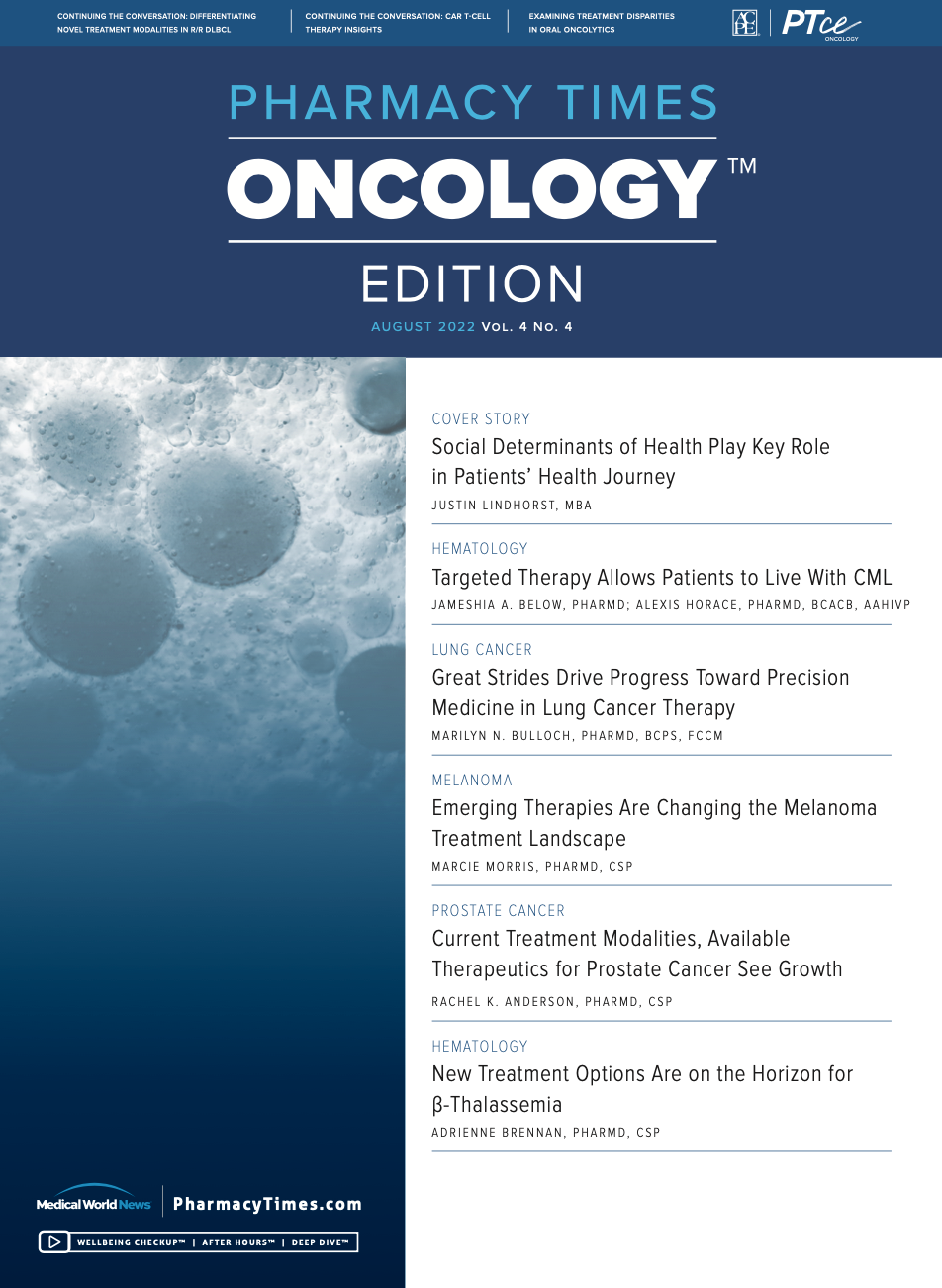Publication
Article
Pharmacy Practice in Focus: Oncology
Emerging Therapies Are Changing the Melanoma Treatment Landscape
Author(s):
Specialty pharmacists play critical role in supporting treatment adherence.
Although melanoma accounts for approximately 1% of skin cancer diagnoses, it is responsible for a large portion of lives lost to the disease, with approximately 8000 deaths predicted to occur in the United States in 2022.1 A
main reason for the high morbidity rate is that melanoma is much more likely to metastasize than other skin cancers.
Despite the high morbidity rate of melanoma, the disease accounts for only 5.6% of all new cancer cases in the United States, with the incidence of melanoma increasing steadily for several decades.1 Based on this statistic, the American Cancer Society estimates that 100,000 new melanoma diagnoses will occur in the United States in 2022.2
Current Treatments
The exact cause of malignant melanoma is unknown, but it is believed to be linked to excessive UV exposure from the sun and tanning beds. As such, most melanomas are highly preventable through limited UV exposure, use of sunscreen, and education about risk factors and warning signs. When detected before it has begun to spread, melanoma also has a 5-year survival rate of 99%.3
Furthermore, surgical resection is often a successful therapy for most patients with melanoma identified early. In more advanced stages, such as metastatic melanoma, patients have historically been treated with standard cancer treatments such as radiation and chemotherapy.1,2
Approved by the FDA in 1998, highdose IL-2 was the first immunotherapy for metastatic melanoma. However, the potential for severe toxicities from IL-2 treatment has resulted in development of newer products with less toxic effects. Further, the treatment landscape of metastatic melanoma has changed immensely in recent advances in targeted therapies and immunotherapy (eg, checkpoint inhibitors) have been more effective than chemotherapy.2,4
Targeted therapy products work by treating melanoma cells directly, with the treatment targets often including mutated genes or proteins involved in regulation of cellular growth and division. Upon mutation, these cells grow and multiply at an uncontrollable rate, with the most common mutation being in the BRAF gene.1
Approximately 50% of all melanomas demonstrate a mutation in the BRAF gene. When this occurs, the MEK gene (and encoded MEK protein) interacts with the BRAF proteins aiding in cell growth.1
Drugs targeting the inhibition of MEK proteins are a common therapy for patients with malignant melanoma and BRAF mutations. Targeted therapies for inhibition of the BRAF and/or MEK proteins include binimetinib (Mektovi;
Pfizer), encorafenib (Braftovi; Pfizer), dabrafenib (Tafinlar; Novartis), trametinib (Mekinist; Novartis), vemurafenib (Zelboraf; Genentech), and cobimetinib (Cotellic; Genentech). Additionally, combining a BRAF inhibitor and a MEK inhibitor is a common approach in treating a patient with a BRAF mutation who needs targeted therapy, as the combination often works better than monotherapy.1,2,4
Advancements have been made with immune checkpoint inhibitors, now a pillar of treatment for advanced melanomas. Unlike targeted therapies, which go after melanoma cells directly, immunotherapy aims to improve the immune system’s ability to identify and destroy melanoma cells. PD-1 inhibitors pembrolizumab (Keytruda; Merck) and nivolumab (Opdivo; Bristol Myers Squibb) and CTLA-4 inhibitor ipilimumab (Yervoy; Bristol Myers Squibb) are included in this class of medications. These drugs actively block proteins involved in decreasing T-cell identification and destruction of melanoma cells. Further, blocking these proteins allows T cells to attack melanoma cells more effectively on their own. Additional immunotherapies such as melanoma vaccines and cell therapy utilizing tumor-infiltrating lymphocytes are being studied as well.1,2,4
Updates in Melanoma Treatment
Effective immunotherapy options for treating advanced melanoma include combination ipilimumab/nivolumab, PD-1 inhibitor monotherapy, and most recently relatlimab/nivolumab fixed-dose combination. On March 18, 2022, the FDA approved nivolumab and relatlimabrmbw (Opdualag; Bristol Myers Squibb) for the treatment of adult and pediatric patients 12 years and older with unresectable or metastatic melanoma. Nivolumab and relatlimab-rmbw is a combination immunotherapy treatment of the PD-1 inhibitor nivolumab with the novel LAG-3–blocking antibody relatlimab, the combination of which has been shown to increase T-cell activation.4
The FDA approval of nivolumab and relatlimabrmbw was based on data from the phase 2/3 RELATIVITY-047 trial (NCT03470922) in which nivolumab and relatlimab-rmbw more than doubled median progression-free survival compared with nivolumab monotherapy, at 10.1 months vs 4.6 months, respectively. There were no new safety events identified with nivolumab and relatlimab-rmbw compared to nivolumab alone.4,5
When used in treatment, nivolumab and relatlimabrmbw are given as a 30 minute intravenous infusion every 4 weeks or until disease progression. However, new and emerging treatments often come with a large financial burden, and nivolumab and relatlimab-rmbw continue this trend at a single infusion wholesale acquisition cost of $27,389 with an annual price tag of $328,668.1,5,6
Role of Specialty Pharmacist
The specialty pharmacist is a key member of any patient’s health care team. They can provide patients and caregivers with medication and disease-specific education prior to and throughout therapy. They play a major role in adverse effect (AE) monitoring and management, along with supporting treatment adherence.
Early recognition and control of AEs can help to prevent unnecessary interruption of medication, thereby improving patient outcomes. Specialty pharmacists can also collaborate and facilitate communication between other segments of the health care team, such as dermatology and oncology, for the treatment of advanced melanoma.
References
1. New drug review: Opdualag. IPD Analytics. Accessed June 16, 2022. https://www.ipdanalytics.com/
2. Melanoma skin cancer. American Cancer Society. Accessed June 16, 2022. https://www.cancer.org/cancer/melanoma-skin-cancer.html
3. Skin cancer facts and statistics. Skin Cancer Foundation. May 2022. Accessed July 25, 2022. https://www.skincancer.org/skin-cancer information/skin-cancer-facts/
4. Oncology: melanoma. IPD Analytics. Accessed June 16, 2022. https://www. ipdanalytics.com/
5. Fecher LA. Considerations for first-line metastatic melanoma: which treatment is best? ASCO Daily News. April 13, 2022. Accessed June 16, 2022. https://dailynews.ascopubs.org/do/10.1200/ADN.22.200895/full/?utm_source=TrendMD&utm_medium=cpc&utm_campaign=ASCO_Daily_Nes_TrendMD_0
6. U.S. Food and Drug Administration approves first LAG-3-blocking antibody
combination, Opdualag (nivolumab and relatlimab-rmbw), as treatment for patients with unresectable or metastatic melanoma. News release. Bristol Myers Squibb. March 18, 2022. Accessed June 16, 2022. https://www.businesswire.com/news/home/20220304005561/en
About the Author
Marcie Morris, PharmD, CSP, is a clinical program manager at AllianceRx Walgreens Pharmacy.







